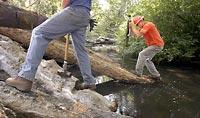Recycling project saves creek habitat for salmon

Huge logs that once held back smaller ones during transport across Puget Sound became another form of support last week.
The old booms, donated by a company that works with loggers, were used to reinforce an eroded section of North Creek in Bothell to aid salmon habitat just before spawning season.
The Adopt-A-Stream Foundation spent several days over the past two weeks hauling in and carefully placing the 40-plus logs to an area of the creek near 228th Street Southeast and Fitzgerald Road. Because that part of the stream makes an abrupt turn, the banks had severely eroded over the years.
Foundation staff members spent hours reinforcing the logs with rebar and anchors to prevent them from floating away. They planned to plant saplings in the nooks between the logs.
"It's a great recycling story," said Tom Hardy, a habitat-restoration specialist with the nonprofit organization. "The logs were used all over the Sound, and now they're sent back on the creek."
The Everett organization works with private-property owners in North King and South Snohomish counties whose land abuts streams, and it applies for grants to improve creeks and riverbeds. In the coming weeks, the group plans to work with a neighboring homeowner to put in a fish passage.
The two projects cost $51,000 and are being mostly funded by the King County Department of Natural Resources and Parks, and the National Fish and Wildlife Foundation. Adopt-A-Stream covered 25 percent of the expense, organization hydrologist Phil Noppe said.
When people live on riverfront property and remove trees that grow naturally along the banks, they can severely damage fish habitat, Noppe said. The property that the organization has been working on, though abandoned for 20 to 30 years, had obviously been cleared in the past.
Trees along a river provide shade and attract food for fish. Downed trunks and branches also serve as natural places where salmon can hide and rest while they make arduous trips upstream to spawn.
Rivers and streams with no natural breaks run much faster and are harder on fish, Noppe said.
"The fish like to hide behind the logs that create a pool for them, a refuge for them to get out of the flow and rest," Hardy said. "They also need shelter from predators when spawning. They need to be able to drop back and hide behind the edges of logs."
This particular creek will typically see sockeye and coho salmon in the fall, Hardy added. Volunteers are working now because the "fish window" from mid-June to early September allows them to be on the creek and cause the least harm to the stream. The salmon will come through midautumn and run through the winter.
The group also works to teach community members about wildlife, organizers said.
It advises landowners to avoid using chemical fertilizers and to try not to have cleared lawns that reach all the way to a creek. Keeping natural foliage, such as willows, along riverbanks is recommended.
"It's hard because people want to be able to see the creek," said John Ucciferri, an Adopt-A-Stream representative. "We tell them to establish where they most view the creek and have a viewing corridor."
Lisa Chiu: 425-745-7804 or lchiu@seattletimes.com